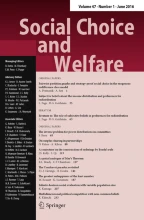Abstract
We introduce a model of (wireless communication) networks: a group of agents want to communicate with each other; an agent has his own position, chooses his costly communication range, and benefits from direct and indirect communications with other agents; any two agents can directly communicate if each agent is located within another agent’s communication range; they can indirectly communicate if each agent is connected to another agent through a sequence of direct communications. Although efficiency and stability are not compatible in a general context, we identify interesting subclasses of problems where an efficient and stable network exists: the uniform interval model, the uniform circle model, and the communication favorable domain. We also investigate the consequence of allowing agents to relocate their positions. For certain networks, relocation-proofness is equivalent to stability.
Similar content being viewed by others
References
Bala V, Goyal S (2000) A non-cooperative model of network formation. Econometrica 68: 1181–1229
Bloch F, Dutta B (2009) Communication networks with endogenous link strength. Games Econ Behav 66: 39–56
Bloch F, Jackson MO (2007) The formation of networks with transfers among players. J Econ Theory 133: 83–110
Dutta B, Jackson MO (2000) The stability and efficiency of directed communication networks. Rev Econ Des 5: 251–272
Dutta B, Mutuswami S (1997) Stable networks. J Econ Theory 76: 322–344
Galeotti A, Goyal S, Kamphorst J (2006) Network formation with heterogeneous players. Games Econ Behav 54: 353–372
Jackson MO (2005) A survey of the formation of networks: stability and efficiency. In: Demange G, Wooders M (eds) Group formation in economics: networks, clubs, and coalitions. Cambridge University Press, Cambridge
Jackson MO, van den Nouweland A (2005) Strongly stable networks. Games Econ Behav 51: 420–444
Jackson MO, Wolinsky A (1996) A strategic model of social and economic networks. J Econ Theory 71: 44–74
Johnson C, Gilles RP (2000) Spatial social networks. Rev Econ Des 5: 273–301
Author information
Authors and Affiliations
Corresponding author
Additional information
We are grateful to Bong Chan Koh, Eun Jeong Heo, an associate editor, and two referees for their comments. This work was supported by the Brain Korea 21 Project in 2006. This paper was written during the second author’s visit to the Osaka University. He is grateful to the Institute of Social and Economic Research for its hospitality.
Rights and permissions
About this article
Cite this article
Hong, S., Chun, Y. Efficiency and stability in a model of wireless communication networks. Soc Choice Welf 34, 441–454 (2010). https://doi.org/10.1007/s00355-009-0409-1
Received:
Accepted:
Published:
Issue Date:
DOI: https://doi.org/10.1007/s00355-009-0409-1
